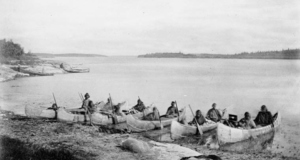The Mystery of Miracles: Examining Religious Providence in the Sixteenth-Century Captivity Narratives of Hans Staden and Cabeza de Vaca
By
2012, Vol. 4 No. 07 | pg. 1/3 | »
KEYWORDS:
Miracles are a complex and fascinating phenomenon. Accounts throughout history have detailed remarkable instances of what people have claimed to be divine intervention, instances that continue to confound and mystify. After all, according to countless individuals, the dead have risen. Sure disaster has been averted. Prayer has led to the dissipation of storms or to the bringing of vital rain. Statues of Mary have cried tears of blood. Though such incredible claims has been gleaned from legitimate primary sources, modern historians find themselves in a quandary when attempting to establish their veracity – it is obviously not an option to declare all of these miracles wholly factual, but it is similarly impossible to deem them complete lies. The actual truth of these stories will never be known, but an investigation into their origins can provide fascinating insight into the minds of the people who crafted them. Tales of religious providence were only expanded upon during the Age of Exploration by European sailors who detailed their experiences in the ‘New World’, weaving yarns that would be shared with the public upon their return home. Whether to justify often violent action against native peoples – often proclaimed as irreligious savages – or to simply establish their mission as righteous, the Christian God was a common presence in their narratives. Miracles, however, seemed to result from more dire, life-threatening circumstances. Two of the most notable sources of miraculous claims are Cabeza de Vaca and Hans Staden, men from different places and different times who were forced to live among different native peoples in the New World. Despite all of these disparities, one similarity is absolutely glaring: both men frequently claimed, in quite a serious manner, to have enacted miracles, something supposedly made possible by their unerring faith in God. If we assume these miracles to have alternative explanations besides the literal intervention of God, what are they? In this paper, I plan to argue that a combination of factors aided in creating the perfect circumstances for these men to assert instances of certain divine intervention. Basic necessity (as both were faced with native demands to “call upon their God”), conscious self-fashioning, desperation, coincidence, and even native ingenuity and cunning – did they use the Europeans for their own benefit? – surely played a role in composing the unbelievable stories of Cabeza de Vaca and Hans Staden. Before exploring these varied and intriguing contributors, an understanding must first be established regarding the circumstances of each man’s voyage to the New World. Álvar Núñez Cabeza de Vaca set out on an expedition in 1527, one of the six hundred men of Pánfilo Narvaez who sought to explore and colonize Spanish Florida. A series of hurricanes and storms would eventually destroy their ship, the crew suffering from starvation, disease, and native attacks. By the end of his decade-long ordeal, Cabeza de Vaca was one of only four survivors.1 He had been humbled by his severe misfortune, made to work for and live with a series of Native American populations for many years; relying on them for all aspects of his life. He was a foreigner in a hostile environment. “And thus,” he wrote in his account, “…we were beseeching our Lord for mercy and the pardon of our sins, shedding many tears, each one having pity not only for himself but for all the others whom they saw in the same state.”2 Such a hopeless situation can certainly engender religious vigor.Hans Staden also found himself a helpless outsider in an unfamiliar land. A mere desire for travel had caused him to volunteer on an ill-fated Spanish expedition in 1557, a voyage that had followed a successful previous expedition with the Portuguese. Though German, his most viable means of sea voyaging were through these foreign maritime powers. Staden found himself forcibly captured in modern-day Brazil by the Tupininbá Indians, a cannibalistic society who devoured their conquered enemies in ritual ceremony. He feared for his life throughout his nine-month captivity, threatened each day with being eaten. The modern introduction to Staden’s Cannibal Captivity makes an apt comparison to Cabeza de Vaca’s narrative: “Unlike Cabeza de Vaca, Staden was by no means the first European to have been encountered,” it explains.3 Staden was immediately recognized as a white (and, mistakenly, Portuguese) enemy upon arrival, whereas Cabeza de Vaca was initially more an object of interest than of direct violence. “The account of Cabeza de Vaca,” the historian continues, “…thus points more to the figure of the castaway than that of the captive in the sense of the kind of captivity endured by Staden.”4 This statement is not so much intended to outline the differences between these two men (as Cabeza de Vaca was, after all, occasionally enslaved and suffered a much more prolonged isolation than Staden) as it is to highlight Staden’s possible reasons for transcribing his narrative: “The drama of Staden’s tale is thus partly connected to the way in which is fate as a sacrificial victim makes his evasion of that destiny all the more remarkable and providential,” the introduction further posits.5 In other words, Staden was fashioning himself into a man that God actively saved through his direct intervention, a man who had been facing a certain death at the hands of savages. What other reason apart from the divine could possibly explain his survival? Such a declaration would have made his already enthralling tale even more noteworthy to his contemporary audience, who would surely be impressed by the many gifts which God had bestowed upon this valiant explorer. Staden also had the direct need establish religious identity among the German people who, upon his return, viewed him as a foreigner and as a religious traitor. He transformed throughout the narrative from a mercenary soldier working for Catholic monarchs into a pious author in Protestant Germany.6 Making this point clear would help to elevate his name among his people, and indubitably aided in the development of his fame. Could such goals have been Staden’s only intent in claiming his ability to exercise miracles? Almost as if Staden saw such a question emerging in the minds of his audience, his narrative is prefaced with a commendation by his respectable associate Dr. Dryander, who fully supported Staden as having an honest spirit: “He has no false cause and he is led neither by ambition nor worldly renown; on the contrary, he seeks only to praise the glory of God and express thankfulness for his salvation,” Dryander confidently writes.7 Nonetheless, the acknowledgement is still made that establishing such character was personally beneficial, therefore proving that lying would also have been beneficial. It cannot be discounted that Staden – while there is likely a grain of truth to each of his stories – may have exaggerated their frequency and certitude to bolster his own reputation. One unique and fascinating theory regarding the shared religious assertions of Staden and Cabeza de Vaca is that both modeled their stories on medieval hagiography, therefore portraying themselves as essential martyrs for their religion. Historian Dwight Raak TenHuisen acknowledges this ancient model as clearly being the “dominant literary precursor”8 to captivity narratives, pointing out that such a tradition was common even after the humanist movement and even within Protestant nations such as Staden’s Germany.9 “Staden’s presentation of the Other reflects the underlying ideology of particularism, and by constructing his self-identity as a martyr saint, Staden constructs barriers that separate him from this other,” TenHuisen elaborates.10 Religion, then, was the means through which he retained his identity among the Tupinimbá, and became vital in constructing his personal identity – leading, therefore, to his narrative being strung with miracles. This idea indicates both conscious self-fashioning and unconscious self-definition; believing in his ability to exercise God’s will may have kept Staden’s mind clear and his will to survive strong. The same theory exists to explain Cabeza de Vaca’s intent, one with a more detailed argument for its validity. Historian Kun Jong Lee argues that Naufragios (which can loosely be translated to Shipwrecks) follows a specific Pauline typology under the medieval tradition of hagiography – Cabeza de Vaca using Saint Paul as a prototype frequently and profoundly throughout the entire recollection.11 His dangerous voyage in the Gulf of Mexico, for example, closely resembles the first leg of Paul’s voyage to Rome through the Mediterranean. In both, the ship touched in several places, all men tried to escape for their lives contrary to the sailor’s code, the crew suffered from terrible hunger, the ship ran aground, and the crew were forced to swim to land.12 Furthermore, Cabeza de Vaca named one of the islands he encountered Malhado, arguably to make it equivalent to Melita, the island upon which Paul had been shipwrecked.13 Jong Lee also observes that, in the first letter from Toribio de Benavente Motolonía – a Franciscan missionary stationed in the New World – to the Count of Benavente that discussed Cabeza de Vaca’s travails, no indication of religious miracles being performed was made at all: “We might, then, presume that the experience of the survivors of the Narváez expedition was endowed with religious significance by both Cabeza de Vaca and Oveido [a sixteenth-century historian] who… relied heavily on the Bible, hagiography, and the medieval legends in their portrayals of the castaways,” he writes.14Continued on Next Page » Suggested Reading from Inquiries Journal
Inquiries Journal provides undergraduate and graduate students around the world a platform for the wide dissemination of academic work over a range of core disciplines. Representing the work of students from hundreds of institutions around the globe, Inquiries Journal's large database of academic articles is completely free. Learn more | Blog | Submit Latest in History |
















